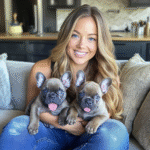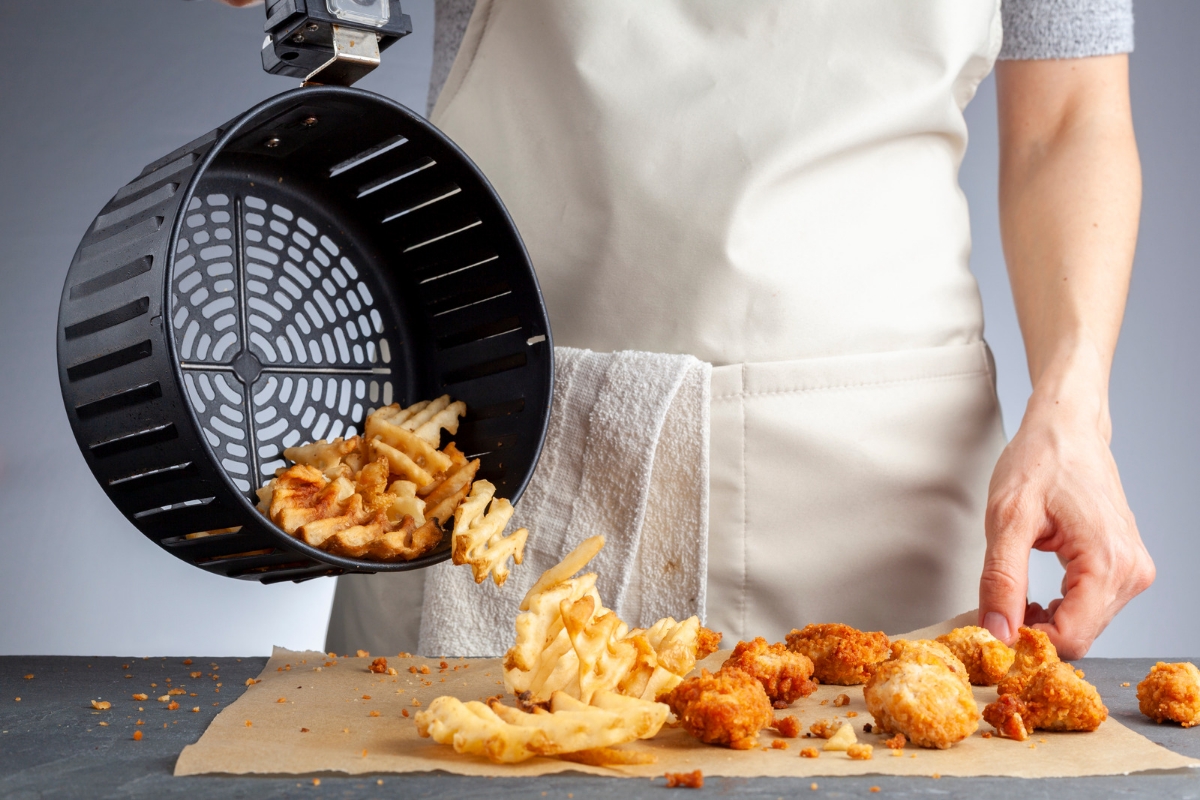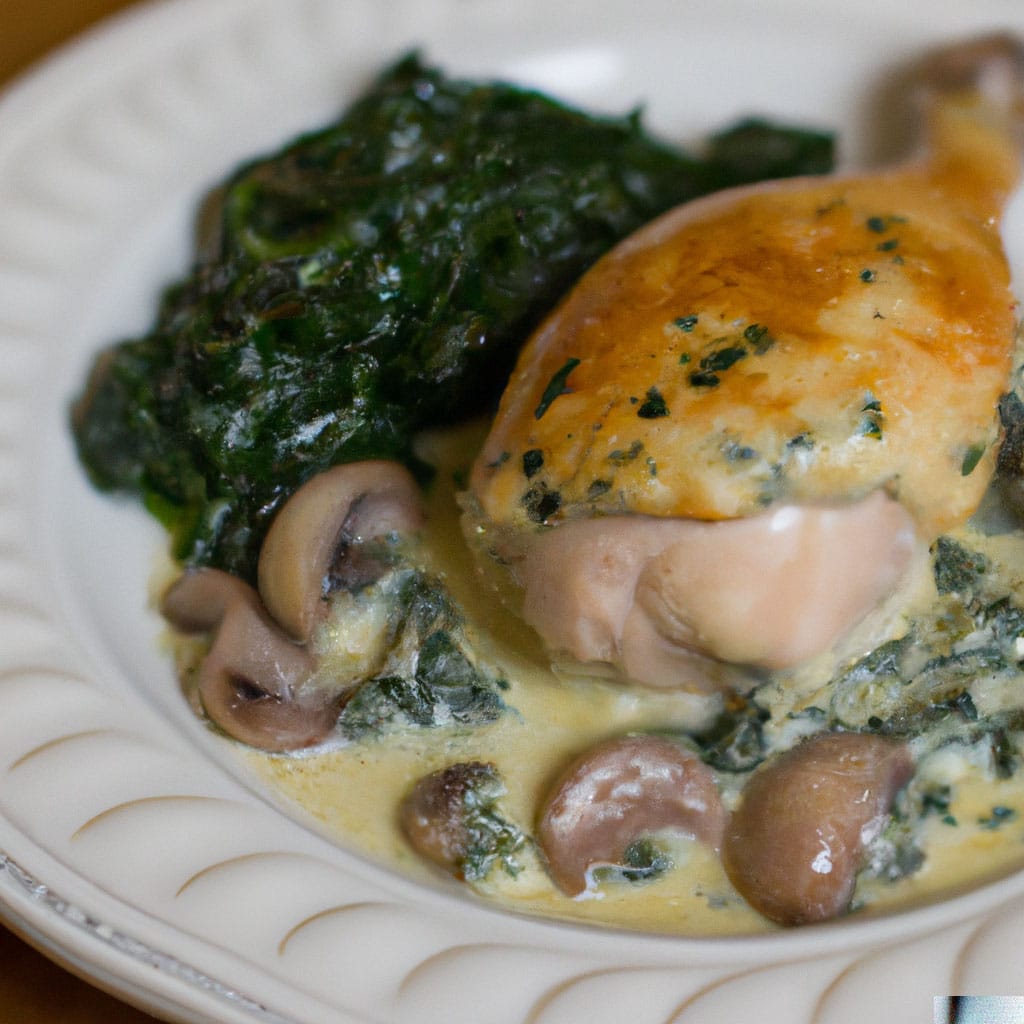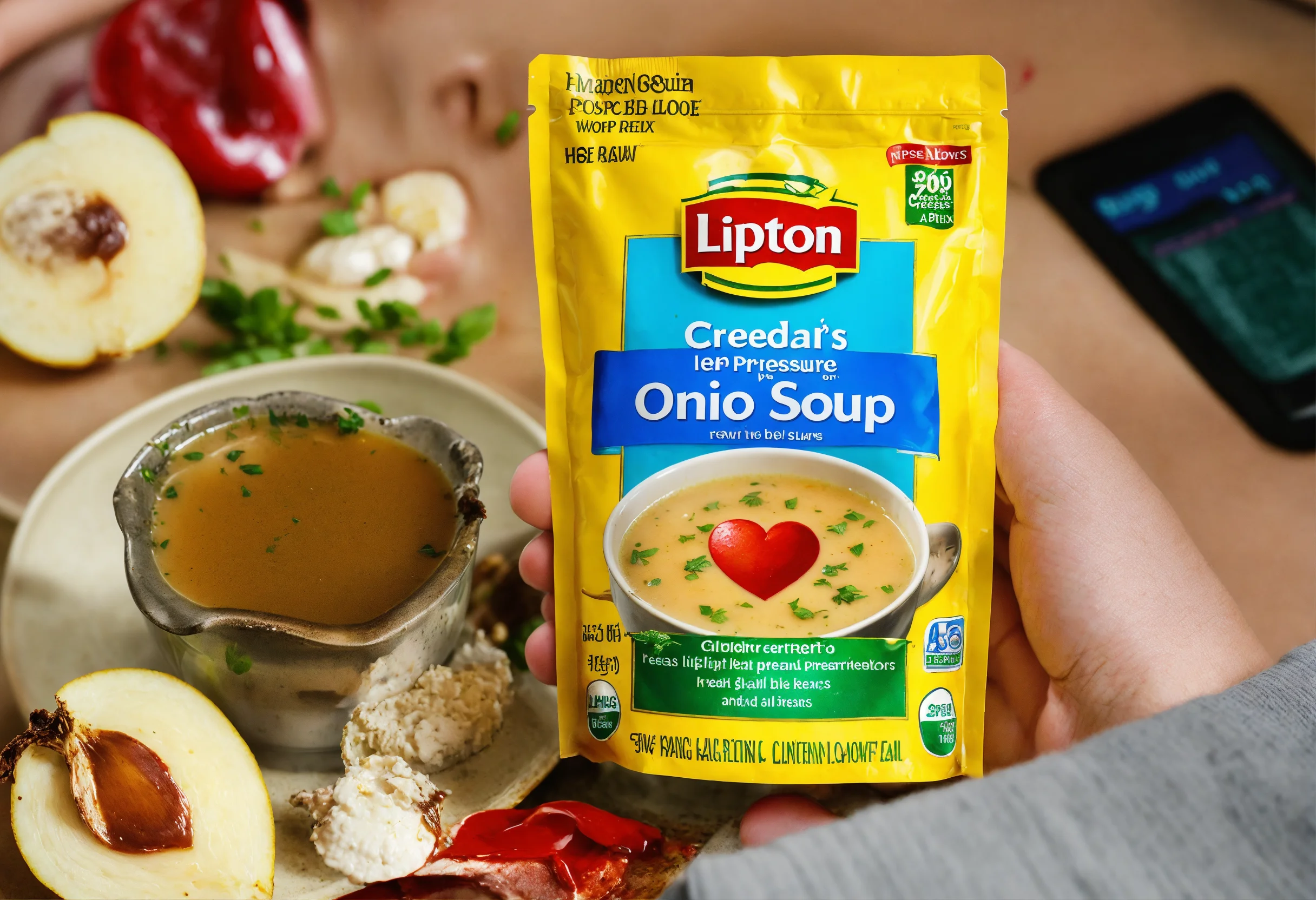When it comes to creating a delightful dessert, few things compare to a cupcake. But what happens if you’re avoiding dairy? That’s where milk-free cupcakes come into play. Whether you’re lactose intolerant, vegan, or just looking for a healthier alternative, dairy-free cupcakes can be just as fluffy and delicious as their traditional counterparts—without sacrificing flavor or texture.
This article will take you through the process of making your very own dairy-free cupcakes, from choosing the right ingredients to creating perfect frosting that’s free from milk, eggs, and other common allergens. Plus, we’ll explore why milk-free cupcakes are a smart choice for everyone—whether you’re baking for a party, whipping up a treat for a loved one with dietary restrictions, or just trying something new. Get ready to discover the secrets of baking delicious, light, and fluffy cupcakes without a single drop of milk.
What is a Milk-Free Cupcake?
What is a Milk-Free Cupcake?

A milk-free cupcake is exactly what it sounds like—a cupcake made without dairy ingredients like cow’s milk or butter. Instead, these delightful treats are made using dairy-free alternatives such as almond milk, coconut milk, or soy milk, and non-dairy butter substitutes like vegetable shortening or vegan butter. This means people who are lactose intolerant or allergic to dairy can still indulge in the sweetness of a classic cupcake without any worries.
But it’s not just those with dairy allergies that are drawn to these cupcakes. As more people adopt plant-based diets, the demand for vegan cupcakes and other plant-based desserts has skyrocketed. These cupcakes are the perfect solution for anyone looking to satisfy their sweet tooth while staying away from animal products.
Why Make Milk-Free Cupcakes?
You might be wondering, why go through the trouble of making a milk-free cupcake when you can easily whip up a traditional one? Well, for starters, many people can’t digest dairy properly—around 65% of the global population is lactose intolerant. That means a significant portion of the world would prefer (or need) lactose-free desserts.
Additionally, making cupcakes without dairy opens up possibilities for more inclusive baking. If you’re hosting a party or event, offering non-dairy or vegan cupcakes ensures that everyone, regardless of dietary needs, can enjoy a sweet treat.
But let’s not forget about the environment. Going dairy-free is a small step toward reducing your carbon footprint. Producing plant-based cupcakes with almond or coconut milk uses fewer resources than dairy production. Cooking with air fryers also saves energy and promotes eco-conscious habits. So, when you make dairy-free cupcakes, you’re not only baking for taste and health, but you’re also making a choice that’s kinder to the planet.
Key Ingredients for Milk-Free Cupcakes
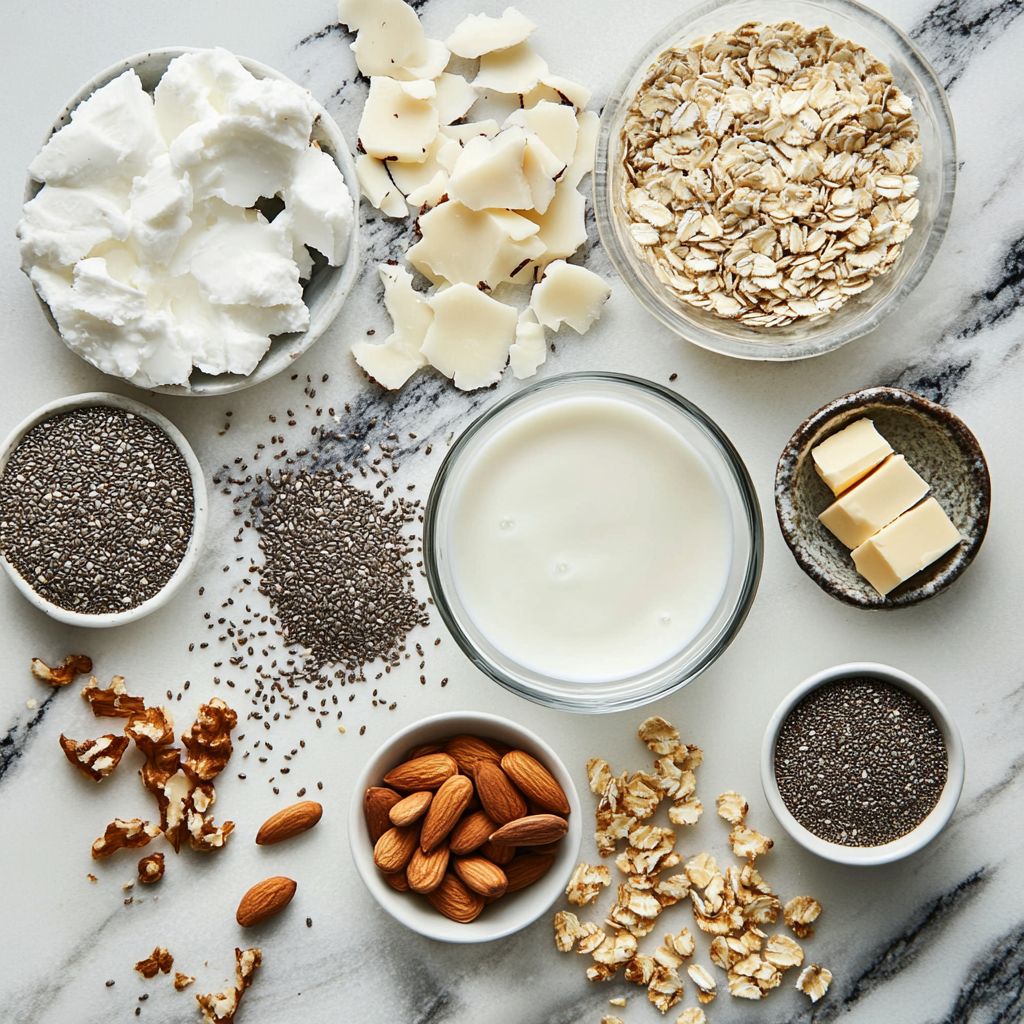
Essential Ingredients for Dairy-Free Cupcakes
When baking dairy-free cupcakes, choosing the right ingredients is crucial. Traditional cupcakes rely heavily on milk and butter for moisture and richness. However, with a few clever swaps, you can achieve the same delicious result using non-dairy alternatives.
Choosing the Right Dairy-Free Milk
The most important ingredient in milk-free cupcakes is the dairy-free milk. Popular options include:
- Almond milk: This is a light, slightly nutty option that works well in most recipes.
- Coconut milk: Perfect for adding a creamy texture and mild sweetness. Be sure to use the carton version, not the canned one.
- Soy milk: It’s one of the thicker alternatives, which can make your cupcakes a bit richer.
- Oat milk: Known for its creamy texture, this option adds a subtle sweetness to your cupcakes.
Regardless of which milk you choose, opt for the unsweetened version to control the sweetness in your recipe. Plant-based milk provides the moisture needed without any of the allergens in cow’s milk.
Butter and Egg Substitutes for Vegan Cupcakes
In addition to the milk swap, replacing butter and eggs is key for making vegan cupcakes or dairy-free cupcakes. These replacements maintain the texture and fluffiness you expect in a cupcake.
Replacing Butter with Non-Dairy Options
To replace butter, there are a few great choices that give your cupcakes the same richness:
- Vegan butter: This is a direct substitute for regular butter and works in the same way.
- Vegetable shortening: This option creates a light and airy texture. It’s excellent for fluffy cupcakes.
- Coconut oil: Adds a subtle coconut flavor and works well in moist, tender cupcakes.
Each of these options can substitute butter in a 1:1 ratio, so no need to alter your recipe measurements.
H3: Egg Substitutes for Egg-Free Cupcakes
If you’re aiming for completely egg-free cupcakes, there are several egg replacements that work wonders:
- Flax eggs: Made by mixing ground flaxseeds with water, this acts as a binder in the batter.
- Chia eggs: Like flax eggs, chia seeds mixed with water form a gel-like consistency to hold the batter together.
- Commercial egg replacers: These are easy to find and work well in most vegan baking recipes.
By using these egg alternatives, you can still create moist, fluffy cupcakes without compromising on texture or flavor.
Step-by-Step Guide to Making Milk-Free Cupcakes
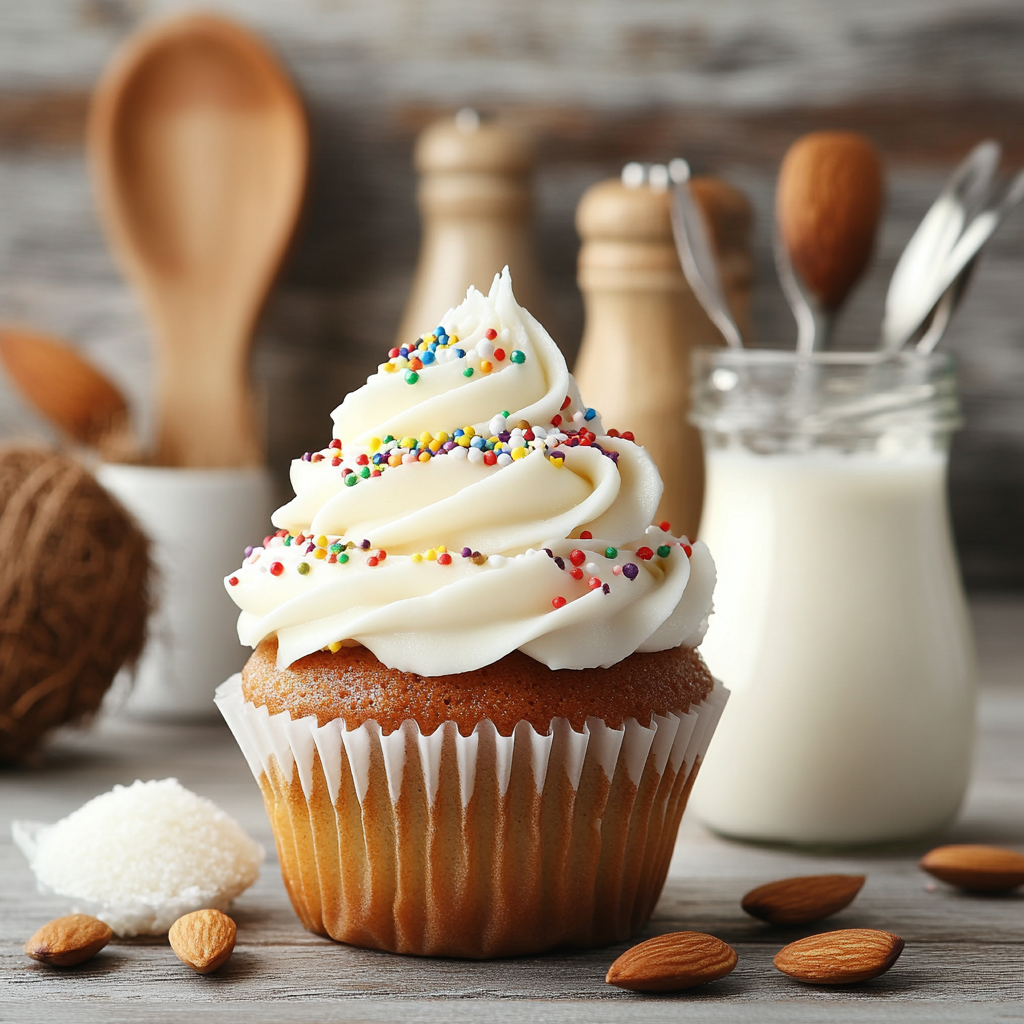
How to Bake Milk-Free Cupcakes at Home
Now that you know the essential ingredients, it’s time to start baking! Follow this simple step-by-step guide to create light, fluffy milk-free cupcakes that everyone will love. With these instructions, you’ll find that making dairy-free and vegan cupcakes is easier than you think.
Mixing Dry Ingredients
Start by preparing your dry ingredients. In a large bowl, whisk together:
- 1 ¾ cups of all-purpose flour
- 1 ½ teaspoons of baking powder
- A pinch of salt
This step ensures that your cupcakes will rise evenly and have a soft, airy texture. Make sure the ingredients are fully incorporated so there are no lumps in your batter.
Creaming the Shortening and Sugar
In a separate mixing bowl, it’s time to cream your dairy-free butter or shortening with sugar. Use an electric mixer to beat:
- ½ cup of vegan butter or vegetable shortening
- 1 cup of sugar
Beat on medium speed for about 2-3 minutes, until the mixture becomes light and fluffy. This process adds air to the batter, ensuring your cupcakes will have a soft and tender crumb.
Adding Non-Dairy Milk and Egg Substitutes
Next, gradually add your dairy-free milk and egg replacers. Here’s what you’ll need:
- 1 cup of almond milk (or any other non-dairy milk of your choice)
- 2 flax eggs (made by mixing 2 tablespoons of ground flaxseeds with 6 tablespoons of water)
Slowly pour the non-dairy milk into the creamed mixture, alternating with the dry ingredients. Start with the flour mixture, add a little at a time, then follow with a splash of almond milk. Repeat until everything is combined. Finally, add the flax eggs and mix until smooth.
Baking and Checking for Doneness
Spoon the batter into a lined cupcake tin, filling each cup about ⅔ full. Preheat your oven to 350°F (175°C) and bake for 18-20 minutes.
To check if the cupcakes are ready, insert a toothpick into the center of one. If it comes out clean, they’re done! If there’s batter on the toothpick, give them another minute or two in the oven. Once done, let the cupcakes cool in the pan for 5-10 minutes before transferring them to a wire rack.
Tips for Perfect Moist and Fluffy Dairy-Free Cupcakes
To make sure your dairy-free cupcakes turn out perfectly every time, here are a few extra tips:
- Don’t overmix: Once your wet and dry ingredients are combined, avoid overmixing the batter, as this can make the cupcakes dense.
- Room temperature ingredients: Ensure your vegan butter or shortening is at room temperature. This allows for smoother mixing and better incorporation with the other ingredients.
- Keep an eye on bake time: Every oven is different, so check your cupcakes a few minutes before the suggested baking time to avoid overbaking.
Frosting and Decorating Milk-Free Cupcakes
Dairy-Free Frosting Options for Milk-Free Cupcakes
Now that your milk-free cupcakes are baked and cooled, it’s time to take them to the next level with frosting. Luckily, there are several dairy-free frosting options that are not only delicious but also simple to make. Let’s explore a few classic and creative options to top off your cupcakes perfectly.
Classic Dairy-Free Buttercream Frosting
You can’t go wrong with a rich and creamy buttercream frosting—especially when it’s dairy-free! Here’s how to make a simple dairy-free buttercream:
Ingredients:
- ½ cup of vegan butter (room temperature)
- 2-3 cups of powdered sugar
- 1 teaspoon of vanilla extract
- 1-2 tablespoons of non-dairy milk (almond or soy milk works well)
Instructions:
- In a large bowl, beat the vegan butter with an electric mixer on medium speed until it’s smooth and creamy.
- Gradually add the powdered sugar, one cup at a time, while continuing to beat the mixture. Add the vanilla extract and a tablespoon of non-dairy milk as needed to reach your desired consistency.
- Once everything is combined, beat the frosting on high speed for about 2-3 minutes to make it extra fluffy.
This dairy-free buttercream is perfect for piping onto your cupcakes, or simply spreading it with a spatula for a smooth finish. Feel free to get creative by adding food coloring or flavor extracts (like almond or lemon) to match the theme of your cupcakes.
Coconut Milk Frosting
For a lighter, tropical twist, coconut milk frosting is an excellent choice. This frosting uses the thick, creamy part of canned coconut milk to create a luxurious topping.
Ingredients:
- 1 can of full-fat coconut milk (chilled overnight)
- 1-2 tablespoons of powdered sugar
- ½ teaspoon of vanilla extract
Instructions:
- Scoop the thick coconut cream from the top of the chilled can, leaving behind the liquid. Place the cream in a bowl.
- Add the powdered sugar and vanilla extract, then beat the mixture with an electric mixer until soft peaks form.
- Once whipped, this frosting is ready to be spread onto your cupcakes.
Note: Since this frosting is lighter than traditional buttercream, it works best for cupcakes that will be served immediately, as it may soften if left at room temperature for too long.
Vegan Chocolate Ganache
If you’re craving a rich and decadent topping, vegan chocolate ganache is the way to go. It’s smooth, velvety, and easy to make with just two ingredients.
Ingredients:
- 1 cup of dairy-free chocolate (chopped or in chips)
- ½ cup of coconut cream (or the solid part of chilled coconut milk)
Instructions:
- Heat the coconut cream in a saucepan over medium heat until it starts to simmer.
- Remove the cream from heat and pour it over the dairy-free chocolate. Let it sit for a minute to melt the chocolate.
- Stir the mixture until smooth and glossy. Allow it to cool slightly before pouring it over your cupcakes for a silky, shiny finish.
Creative Decorations for Non-Dairy Cupcakes
Frosting is just the beginning! The decorations you choose can add extra fun and flavor to your milk-free cupcakes. Here are some creative ideas:
Toppings for Lactose-Free Cupcakes
- Sprinkles: Add a pop of color with rainbow sprinkles, or go for something elegant like gold dust or edible glitter.
- Fresh fruit: Top your cupcakes with sliced strawberries, blueberries, or raspberries for a fresh, fruity twist.
- Chopped nuts: Almonds, walnuts, or pecans can add a nice crunch and complement dairy-free buttercream or coconut milk frosting.
- Non-dairy chocolate shavings: Use a vegetable peeler to create chocolate curls from dairy-free chocolate, adding an elegant touch to your cupcakes.
Gluten-Free and Vegan-Friendly Variations
If you want to cater to even more dietary needs, consider making gluten-free versions of your milk-free cupcakes. Simply swap out regular flour for a gluten-free baking blend. You can also experiment with healthier options, such as using coconut sugar instead of refined sugar, or adding natural sweeteners like maple syrup.
By combining these creative toppings with your choice of frosting, you’ll have cupcakes that look as good as they taste, while being dairy-free, vegan, and allergen-friendly.
Nutritional Benefits of Milk-Free Cupcakes
Health Benefits of Dairy-Free and Vegan Cupcakes
One of the biggest perks of making milk-free cupcakes is their nutritional benefits. By avoiding dairy, you’re cutting out a major source of saturated fats and cholesterol, making these treats lighter on your body. Whether you’re baking for dietary restrictions or just aiming for a healthier dessert, dairy-free cupcakes offer a tasty alternative to traditional cupcakes without compromising on flavor.
Lower in Saturated Fats and Cholesterol
Traditional cupcakes rely on butter and milk, both of which are high in saturated fats and cholesterol. By substituting these with non-dairy alternatives like vegan butter, coconut oil, or plant-based milks, you’re significantly reducing the saturated fat content. For those watching their cholesterol levels or looking to improve heart health, these changes can make a big difference. For example, using almond milk or oat milk in place of cow’s milk cuts out cholesterol entirely, since plant-based milks contain none.
Rich in Plant-Based Ingredients
Not only are dairy-free cupcakes lower in cholesterol, but they also pack in more nutrients from the plant-based ingredients used in their recipes. Almond milk, for instance, is a good source of vitamin E and calcium, while coconut milk provides medium-chain triglycerides (MCTs) that can boost metabolism and support brain function. Moreover, using flax eggs or chia eggs adds fiber and omega-3 fatty acids, which are great for heart health and overall well-being.
Are Milk-Free Cupcakes Suitable for All Dietary Needs?
One of the most appealing aspects of milk-free cupcakes is how versatile they are. With a few tweaks, they can meet various dietary needs, from gluten-free to low-sugar diets. Here’s how you can adjust your cupcakes to suit different dietary preferences:
Gluten-Free and Soy-Free Options
If you’re catering to someone with gluten intolerance, it’s easy to turn your dairy-free cupcakes into gluten-free ones by swapping out the all-purpose flour for a gluten-free baking blend. Make sure to choose a blend that includes xanthan gum or another binding agent, as this helps provide the structure that gluten normally gives.
Similarly, for those avoiding soy, use coconut milk or almond milk instead of soy milk in the recipe. Always double-check your vegan butter and other substitutes to ensure they’re also soy-free, as some products may contain soy derivatives.
Low-Sugar and Natural Sweeteners
If you’re watching your sugar intake, consider using natural sweeteners like maple syrup, agave nectar, or coconut sugar in place of refined white sugar. These alternatives not only reduce the glycemic load of the cupcakes but also add unique flavors that complement the ingredients. For a lower-calorie option, you can use a sugar substitute like stevia or monk fruit sweetener. Just be sure to adjust the recipe slightly, as these sweeteners are often much sweeter than traditional sugar.
FAQs about Milk-Free Cupcakes
Frequently Asked Questions about Milk-Free Cupcakes
Baking milk-free cupcakes can be a new adventure, especially if you’re used to traditional recipes. To help you navigate the process, here are answers to some of the most common questions people have when making dairy-free or vegan cupcakes. Whether you’re wondering about substitutions, storage, or taste, we’ve got you covered!
Many people are drawn to vegan cupcakes because they align with plant-based diets and offer health benefits. Check out the latest research on vegan diets at NutritionFacts.org.
Can I Make Milk-Free Cupcakes Without Eggs?
Yes, absolutely! If you’re aiming for vegan or egg-free cupcakes, there are plenty of egg substitutes that work well. Flax eggs and chia eggs are popular options, and they are super simple to make. Just mix 1 tablespoon of ground flaxseeds or chia seeds with 3 tablespoons of water, let it sit for a few minutes until it becomes gel-like, and you’re good to go! These substitutes act as binders in your batter, giving you the same texture as eggs would.
Another option is using a commercial egg replacer, which is designed specifically for baking and works well in most recipes. This ensures that your dairy-free cupcakes are light and fluffy without needing eggs.
What’s the Best Dairy-Free Milk for Baking Cupcakes?
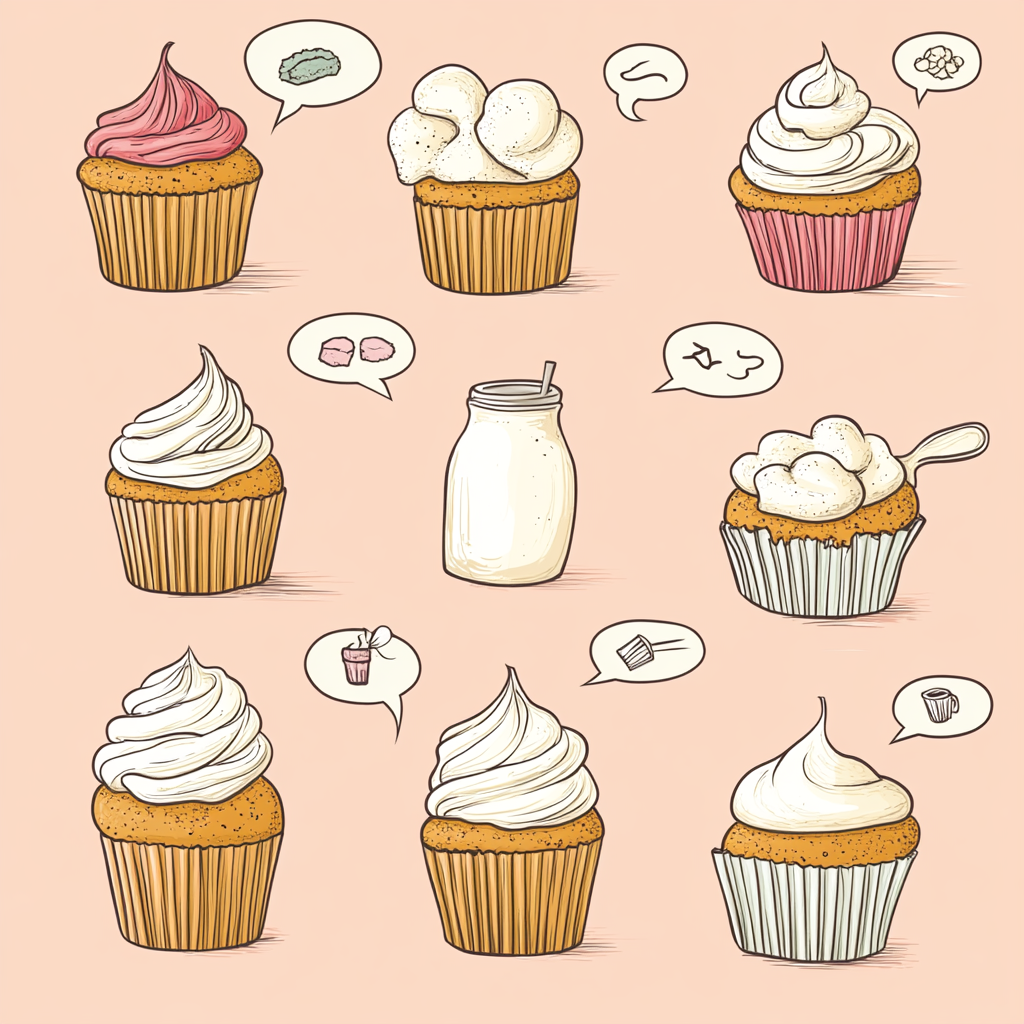
There are several great non-dairy milk options, and the best one depends on the flavor profile you’re looking for. Here are some popular choices:
- Almond milk: This is a versatile option with a mild, nutty flavor that works well in almost any recipe.
- Coconut milk: Great for a richer, creamier texture, and it adds a subtle coconut flavor.
- Oat milk: Known for its creamy consistency, oat milk is a good choice for those who want a neutral flavor.
- Soy milk: This is the most similar to cow’s milk in terms of protein content, making it a good choice for baked goods that need structure.
Each of these plant-based milks works beautifully in dairy-free cupcakes, so you can pick whichever one suits your taste and dietary needs.
Plant-based milk provides the moisture needed without any of the allergens in cow’s milk. Learn more about the nutritional benefits of plant-based alternatives on Nutrition.gov
Can You Freeze Milk-Free Cupcakes?
Yes, you can absolutely freeze milk-free cupcakes! Freezing is a great way to make them ahead of time or to store leftovers. Here’s how you do it:
- Let the cupcakes cool completely after baking.
- Place them in an airtight container or wrap them individually in plastic wrap to prevent freezer burn.
- Freeze the cupcakes without frosting for up to 3 months.
When you’re ready to eat them, just let them thaw at room temperature. Once thawed, you can frost them and enjoy! If you’ve already frosted the cupcakes, freeze them uncovered for about an hour, then wrap them individually to keep the frosting intact.
How Do Milk-Free Cupcakes Taste Compared to Regular Cupcakes?
The short answer: they taste amazing! Many people are surprised by how similar milk-free cupcakes are to traditional cupcakes in terms of flavor and texture. With the right dairy-free substitutes, your cupcakes will be just as moist, fluffy, and delicious as any other.
In fact, some people prefer the lighter feel of vegan cupcakes because they often contain healthier fats, like coconut oil or plant-based butter. The key is in choosing quality ingredients and following the recipe carefully. Your guests may not even notice the difference!
Wrapping Up the FAQs
Hopefully, these answers clear up some of the most common concerns about making milk-free cupcakes. With the right ingredients and techniques, you can confidently bake cupcakes that are not only dairy-free but also versatile and delicious. In the final section, we’ll recap the external resources and helpful links to further improve your milk-free baking experience!
